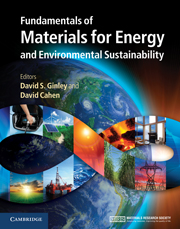Book contents
- Frontmatter
- Contents
- Contributors
- Preface
- Acknowledgments
- Part 1 Energy and the environment: the global landscape
- Part 2 Nonrenewable energy sources
- Part 3 Renewable energy sources
- 17 Solar energy overview
- 18 Direct solar energy conversion with photovoltaic devices
- 19 Future concepts for photovoltaic energy conversion
- 20 Concentrating and multijunction photovoltaics
- 21 Concentrating solar thermal power
- 22 Solar thermoelectrics: direct solar thermal energy conversion
- 23 Off-grid solar in the developing world
- 24 Principles of photosynthesis
- 25 Biofuels and biomaterials from microbes
- 26 Biofuels from cellulosic biomass via aqueous processing
- 27 Artificial photosynthesis for solar energy conversion
- 28 Engineering natural photosynthesis
- 29 Geothermal and ocean energy
- 30 Wind energy
- Part 4 Transportation
- Part 5 Energy efficiency
- Part 6 Energy storage, high-penetration renewables, and grid stabilization
- Summary
- Appendix A Thermodynamics
- Appendix B Electrochemistry
- Appendix C Units
- Index
- References
28 - Engineering natural photosynthesis
from Part 3 - Renewable energy sources
Published online by Cambridge University Press: 05 June 2012
- Frontmatter
- Contents
- Contributors
- Preface
- Acknowledgments
- Part 1 Energy and the environment: the global landscape
- Part 2 Nonrenewable energy sources
- Part 3 Renewable energy sources
- 17 Solar energy overview
- 18 Direct solar energy conversion with photovoltaic devices
- 19 Future concepts for photovoltaic energy conversion
- 20 Concentrating and multijunction photovoltaics
- 21 Concentrating solar thermal power
- 22 Solar thermoelectrics: direct solar thermal energy conversion
- 23 Off-grid solar in the developing world
- 24 Principles of photosynthesis
- 25 Biofuels and biomaterials from microbes
- 26 Biofuels from cellulosic biomass via aqueous processing
- 27 Artificial photosynthesis for solar energy conversion
- 28 Engineering natural photosynthesis
- 29 Geothermal and ocean energy
- 30 Wind energy
- Part 4 Transportation
- Part 5 Energy efficiency
- Part 6 Energy storage, high-penetration renewables, and grid stabilization
- Summary
- Appendix A Thermodynamics
- Appendix B Electrochemistry
- Appendix C Units
- Index
- References
Summary
Focus
What is called in this chapter the “engineering” of natural photosynthesis has been performed by evolution over several billions of years. Its optimization, against thermodynamic and other selection criteria from the biological environment, has led to a remarkably limited set of molecular and supramolecular motifs. Photosynthesis starts with absorption of light by mutually interacting chlorophyll (Chl) and related molecules. These are embedded in protein matrices that promote rapid transport of energy by excitons and lower the energy of transition states for charge separation and multielectron catalysis. An understanding of engineered natural photosynthesis is the underpinning of the design of artificial solar-to-fuel devices.
Synopsis
Light energy is abundant and evenly spread over the surface of the Earth, and virtually all organisms depend on the conversion and chemical storage of light energy by natural photosynthesis. The advent of natural photosynthesis opened up new energy conversion pathways for progression toward thermodynamic equilibrium between the very hot Sun and the much colder Earth. The first-principles thermodynamic and mechanistic analysis of how natural photosynthesis is engineered by biological evolution in this chapter shows that combining different functionalities of light harvesting, charge separation, and catalysis in small molecules or at a single narrow interface is incompatible with high solar-to-fuel conversion efficiency, and that possible solutions to the problem of accumulation of solar energy in chemicals require complex device topologies. This led biology to a modular design approach that is the basis of photosynthesis. It is the result of an intensive evolutionary effort of shaping complex structures, driven by the abundant solar energy spread over the planet.
- Type
- Chapter
- Information
- Publisher: Cambridge University PressPrint publication year: 2011
References
- 2
- Cited by



